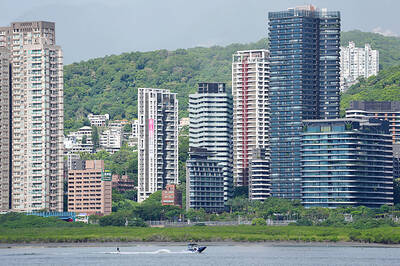Miaoli County-based tile producer Champion Building Materials Co (冠軍建材) yesterday posted revenue of NT$900 million (US$31.97 million) for last quarter, up 8.55 percent from three months earlier, as demand improved alongside the property market’s recovery from a local COVID-19 outbreak.
The quarterly sales were the strongest in four quarters, aided by revenue growth of 10 percent to NT$291 million last month, it said in a statement.
Inventory demand picked up significantly last month from major customers in Taiwan, which generated 93.32 percent of its topline, while China accounted for the remaining 6.68 percent, Champion said.
The company operates 10 showrooms nationwide and collaborates with 203 building material suppliers, making it the largest sales network.
Housing transactions in Taiwan accelerated after COVID-19 infections dwindled, encouraging developers to launch new products, it said, adding that decoration demand also lent support to its business.
The company is engaged in the manufacture and trading of ceramic tiles: polished tiles, quartz tiles, external wall tiles, slate tiles, floor tiles and interior wall tiles.
Champion said it also benefited from global port congestions, which disrupted shipments of imported tiles.
This boosted its sales of slate tiles and external wall tiles, which accounted for 35 percent and 21 percent of third-quarter revenue, compared with 29 percent and 17 percent respectively a year earlier, it added.
The company is upbeat about business this quarter, the high season for the housing market.
Champion shares slid 1.33 percent to close at NT$11.1 in Taipei trading yesterday, deeper than the TAIEX’s 1.07 percent retreat, Taiwan Stock Exchange data showed.

Taiwan’s rapidly aging population is fueling a sharp increase in homes occupied solely by elderly people, a trend that is reshaping the nation’s housing market and social fabric, real-estate brokers said yesterday. About 850,000 residences were occupied by elderly people in the first quarter, including 655,000 that housed only one resident, the Ministry of the Interior said. The figures have nearly doubled from a decade earlier, Great Home Realty Co (大家房屋) said, as people aged 65 and older now make up 20.8 percent of the population. “The so-called silver tsunami represents more than just a demographic shift — it could fundamentally redefine the

Businesses across the global semiconductor supply chain are bracing themselves for disruptions from an escalating trade war, after China imposed curbs on rare earth mineral exports and the US responded with additional tariffs and restrictions on software sales to the Asian nation. China’s restrictions, the most targeted move yet to limit supplies of rare earth materials, represent the first major attempt by Beijing to exercise long-arm jurisdiction over foreign companies to target the semiconductor industry, threatening to stall the chips powering the artificial intelligence (AI) boom. They prompted US President Donald Trump on Friday to announce that he would impose an additional

China Airlines Ltd (CAL, 中華航空) said it expects peak season effects in the fourth quarter to continue to boost demand for passenger flights and cargo services, after reporting its second-highest-ever September sales on Monday. The carrier said it posted NT$15.88 billion (US$517 million) in consolidated sales last month, trailing only September last year’s NT$16.01 billion. Last month, CAL generated NT$8.77 billion from its passenger flights and NT$5.37 billion from cargo services, it said. In the first nine months of this year, the carrier posted NT$154.93 billion in cumulative sales, up 2.62 percent from a year earlier, marking the second-highest level for the January-September

Asian e-commerce giant Shein’s (希音) decision to set up shop in a historic Parisian department store has ruffled feathers in the fashion capital. Anger has been boiling since Shein announced last week that it would open its first permanent physical store next month at BHV Marais, an iconic building that has stood across from Paris City Hall since 1856. The move prompted some French brands to announce they would leave BHV Marais, but the department store had already been losing tenants over late payments. Aime cosmetics line cofounder Mathilde Lacombe, whose brand was among those that decided to leave following